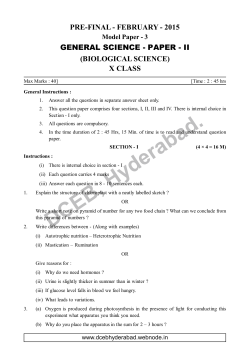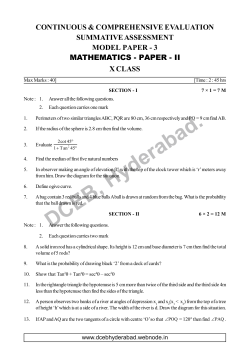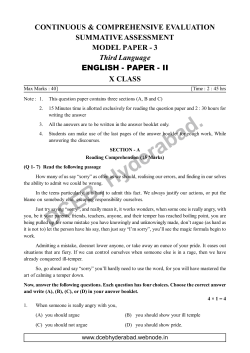
(Set - 1) EM
MODEL PAPER - 1 1 CONTINUOUS AND COMPREHENSIVE EVALUATION Model Paper - 1 SOCIAL STUDIES - PAPER - I X CLASS Max Marks : 40] [Time : 2 : 45 hrs General Instructions : (i) This questions paper contains 4 sections (I, II, III, IV) (ii) Answer all the questions (iii) Internal choice is there in section - I . d (iv) Total time allotted for the exam in 2 : 45 hours. Out of which 15 min. are kept for reading and understanding the questions paper. a b ra (v) For multiple choice questions, choose the correct answer and write the question number and answer in your answer book. Section - I Instructions : (i) Answer all the questions (ii) Each question carries 4 marks. e d y H 4 × 4 = 16 (iii) Each question has internal choice. Select one out of the two questions given. , B E C D (iv) Answer each question in 8 to 10 sentences. 1. (a) What are the problems of urbanization? (OR) (b) What measures can be taken up for environmentally sustainable development? 2. (a) Read the following paragraph and comment on it. Developed countries want developing countries to cut down on burning coal and other activities that add greenhouse gases to the atmosphere. Developing countries argue that developed countries developed precisely by burning fossil fuels in their development. Developing countries say that their economic development will be seriously damaged if they don't burn fossil fuels (mainly coal), and that developed countries should do their share of work to help find alternatives that can help the developing countries to progress. (OR) (b) Read the following paragraph and write your opinion about it. Economic proponents of globalization argue that it is economic forces that are responsible for globalization and control its contours and borders. These holding the political line argue it is the government decisions that allow movement in the first place. Governments place restrictions or ease regulations. The attractiveness of places has to do with the political climate and not necessarily the market conditions and therefore territory still matters. In reality, both are connected. We must remember that political decisions are taken in a particular context, which accounts for the economic and technological change that has already taken place. www.dcebhyderabad.webnode.in SOCIAL STUDIES - PAPER - I 3. 2 Observe the following graph and answer the questions. Questions e d y H a b ra . d (i) How much populations has increased on account of migration from rural to urban areas during the years 1961 - 2011. (ii) How much is the urban population in the last decade? , B E C D (iii) Which indicator is the main cuase for the growth of urban population? (iv) During 1981 - 91 how much population was added to the urban populationduetodeclarationof rural areasas urban areas and expansion of urban areas. (OR) (b) Observe the following pie charts and prepare a sutiable table. 4. (a) Locate the following in the given India map mark the flow of major peninsular rivers. (OR) (b) (i) Konkan coast (iii) Mishni Hills (ii) Undagamanlalam (iv) Aravalis. www.dcebhyderabad.webnode.in MODEL PAPER - 1 3 Section - II Instructions : (i) 6 × 2 = 12 Answer all the questions (ii) Each question carries 2 marks. (iii) Answer each question in 4 to 5 sentences. 5. Do you think that parents give equal importance to girls eudcation and boys education. 6. What is the impact of agricultural diversification? 7. Observe the following graph and answer the questions below. Questions (i) , B E C D e d y H a b ra Which was the least producing sector in 1972 - 73? (ii) What is the aggregate value of all the sectors in 2009-10? 8. Read the following map and answer the questions below. (i) By what name is river Brahmaputra known in Tibet? ( ii) Name two tributaries that join river Ganga from peninsular India. 9. Prepare a poster on girl education. 10. Do you appreciate globalistion www.dcebhyderabad.webnode.in . d SOCIAL STUDIES - PAPER - I 4 Section - III Instructions : (i) 7×1=7 Answer all the questions (ii) Each question carries 1 marks. (iii) Each answer to be written in either 1 or 2 sentences. 11. What is gross domestic product? 12. Name the turin sources of river Ganga. 13. What does "the site" refer to? 14. Name two large Indian companies that emerged as MNCs. 15. How is the availability of food grains for the year estimated? 16. What is environment's source function? 17. Write two slogans on food security. Section - IV Instructions : (i) Answer all the questions (ii) Each question carries ½ marks. e d y H a b ra . d 10 × ½ = 5 (iii) Each questions has four alternatives and choose the correct one and write the same in the answer sheet along with the questions number. 18. The northern most range of Himalayas is known as , B E C D (A) Himachal (C) Shinaliks 19. (C) 92 20. 21. ] [ ] [ ] [ ] [ ] (B) Himadri (D) Outer Himalayas The percentage of workers in India working in unorganised sector is (A) 90 [ (B) 91 (D) 93 The winds that blow during summer over northern plains of India are (A) Mistral (B) Chinook (C) Fohn (D) Loo The census of India is organised, collected and recorded by (A) Ministry of finance (B) Ministry of Defence (C) The registrar general and census commission of India (D) Planning commission of India 22. According to 2011 census the female literacy rate is (A) 82.14 % (B) 64.84 % (C) 70.04 % (D) 65.46 % www.dcebhyderabad.webnode.in MODEL PAPER - 1 23. 5 Metropolitan cities have population [ ] [ ] [ ] [ ] [ ] (A) Between five thousand to one lakh (B) Between one lakh to one million (C) Between one million to ten millions (D) Between ten million to twenty millions 24. UNDP is (A) United Nations Disasmament Programme (B) United Nations Development Programme (C) United Nations District level Programme (D) United Nations Development Project 25. 26. As per national food security act every low income family is entitled for (A) 3 kgs of food grains (B) 4 kgs of food grains (C) 5 kgs of food grains (D) 6 kgs of food grains Article 21 of Indian constitution guarantees (A) Right to life (B) Right to freedom (C) Right to religion 27. a b ra e d y H (D) Right Against Exploitation The emigration act 1983. Protects the interests of (A) International migrants , B E C D (C) Rural migrants . d (B) Urban migrants (D) National migrants. www.dcebhyderabad.webnode.in
© Copyright 2025


















